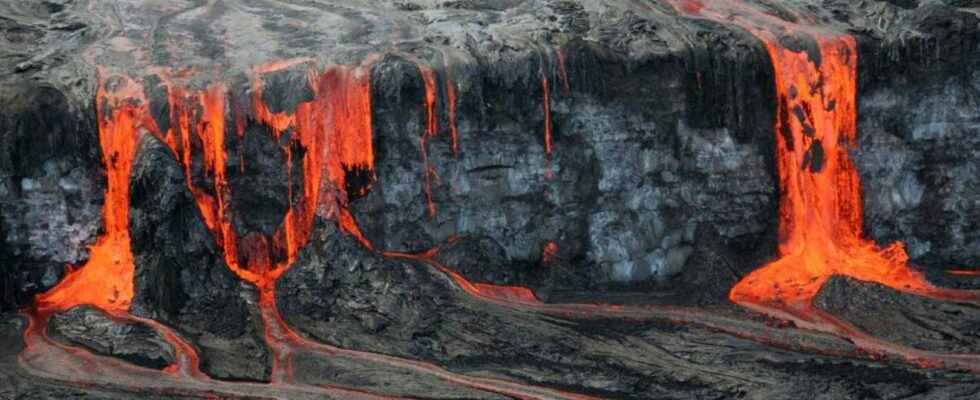You will also be interested
[EN VIDÉO] Kilauea volcano eruption Cascading lava plunges into the lake in multiple places, causing local upwellings. As the waterfalls enter the lava lake, they cause the surface of the lake to slide and pull pieces of cooled crust below the surface.
L’Iceland, Hawaii, the Canary Islands or the Azores are volcanic islands whose existence is directly linked to the presence of hot spots. These large anomalies thermal that take root deep in the mantle are indeed at the origin of an intense volcanism on the surface of the Earth.
Why is the footprint of hotspots on the Earth’s surface an essential piece of data?
In the oceans, the imprint of these hotspots is particularly visible thanks to the generation of long chains of volcanoes which often form chains of volcanic islands as the oceanic crust moves above the hotspot which , is considered to be relatively fixed. But the principle of plate tectonics is that the entire surface of the Earth is in movement.
Cyclically, continents come together, then separate. It can therefore happen that a continent finds itself above a hot spot. As in the oceanic domain, this situation generally generates significant volcanism, of the traps or LIP (Large Igneous Province, large magmatic province). But if the hot spot is under a continental crust very thick, which is the case of cratons, volcanism is then much less visible, or even non-existent. This type of context is currently found in Africa and Greenland. The two particularly thick continental plates are in fact located above diapirs mantle. As a reminder, an oceanic crust is on average 7 km thick while a craton (very old continental crust) can be 40 km (against 30 for a normal continental crust).
Following the trace that the hot spots print on the surface of the Globe is very important since it makes it possible to connect the old magmatic provinces to the current hot spot volcanoes. This type of data is essential to understand the movement of the plates over time and to perform accurate paleogeographic reconstructions. Two researchers from the University of Oslo have thus developed digital models accounting for the interactions between the mantle diapir and the continental lithosphere. The objective is to characterize, in this context, the amplitude of the surface heat flux anomaly as well as its evolution.
The base of the lithosphere is eroded by the heat of the hot spots
The thermal flux that can be measured on the surface represents the quantity of heat which passes through the crust at any given time. The spatial but also temporal variations of this heat flow thus make it possible to obtain a great deal of information on the state of the lithosphere.
The results, published in Geophysical Research Letters, show that the passage of a continent over a hot spot causes a thinning of the continental lithosphere. We can speak of basal erosion of the lithosphere. Contrary to the process of mechanical erosion that we usually know and which describes the wear and degradation of rocks by the action of wind or water, the erosion of the base of the lithosphere is both mechanical and thermal.
It should be remembered that the continental lithosphere is composed of the crust and the coat superior. The base of the lithosphere is therefore not defined as a mineralogical limit but as a thermal limit, which defines a change in the rheological behavior of the mantle: the transition between the lithosphere and theasthenosphere thus follows the 1,300°C isotherm. In the presence of a hot spot, the depth of this isotherm will be modified. In this case, the 1,300°C isotherm will rise, giving rise to a thinning of the continental lithosphere. On the other hand, when the heat source moves, the lithosphere will rebalance itself: the 1,300°C isotherm will tend to drop, leading to a re-thickening of the lithosphere.
A heat flow anomaly that persists over time
Although it is consistent to observe greater heat fluxes at the level of the thinned zones, the numerical models show however that the heat flux anomaly reaches its maximum 40 to 140 million years after this episode of thinning of the the lithosphere in the presence of a hot spot. This delay would be related to the process of heat conduction through the crust, which is relatively slow. These results show that current hotspots can be identified through continental lithosphere thinning. The heat flow would, for its part, make it possible to trace the hot spots over time. This also implies that the presence of a hot spot can influence the heat flow of a region over a very long period, even when the plate is no longer directly above the mantle thermal anomaly.
Interested in what you just read?
